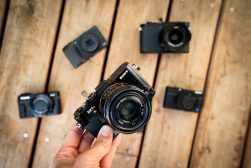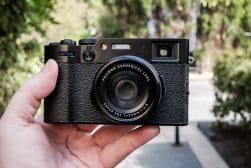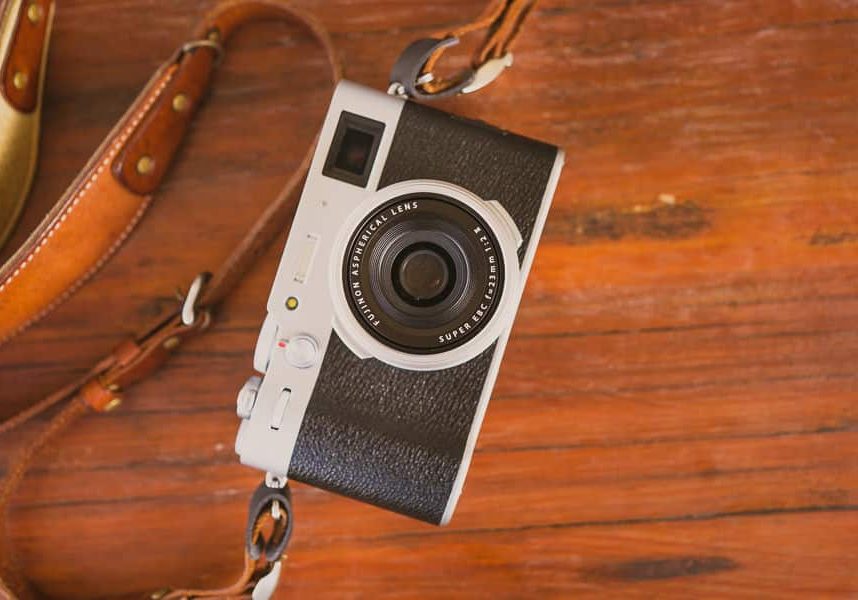
Fujifilm X100V Camera Review for Everyday Photography
An in-depth Fujifilm X100V review by a professional photographer who wanted to rekindle his love for photography. A must-read for any level photographer!
A word of warning – this Fujifilm X100V review is likely to leave a dent in your wallet…
I don’t work for Fujifilm, nor am I biased in any way (I shoot Sony professionally, and have used Nikon for over 10 years too).
However, this little retro-inspired APS-C camera has me seriously impressed.
Enough so, in fact, that I’ve dropped a fair chunk of change on a camera I don’t actually need, at the start of an economic recession…
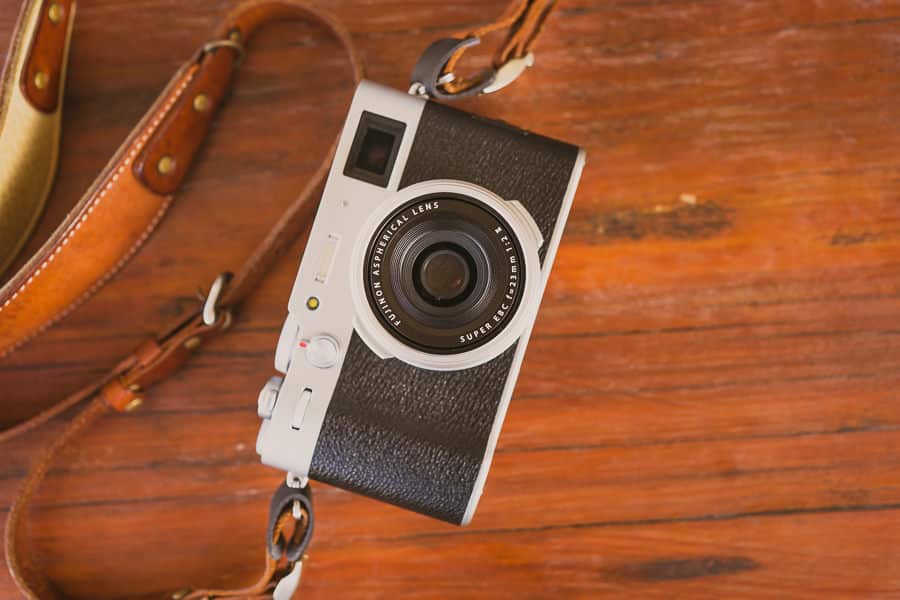
Gorgeous, retro-inspired compact camera that's a ton of fun to shoot, with excellent image quality and a unique feature set.
TechRadar called it “the compact camera that makes sense in a smartphone world”, and I have to say I agree.
With iPhones and Google Pixels blurring backgrounds and capturing images in near-darkness, the humble point and shoot needs to be seriously good to warrant space in our jacket pockets.
Fujifilm have managed to achieve this with the X100V.
I’ve owned 3 previous versions of the X100, including its predecessor, the X100S… but the V is first model I wholeheartedly recommend to any level of photographer.
Let’s get stuck in to the review.
Fujifilm X100V Specs
- Beautiful minimal design
- Unique film simulations
- Excellent JPEG/RAW image quality
- Great RAW quality
- Tilting touchscreen very well implemented
- Much improved auto-focus
- Much improved lens, especially at f/2
- Surprisingly good movie mode
- Poor grip
- AF speed could still be quicker
- Full weather-sealing requires additional purchases
- 26.1 MP X-Trans sensor
- Redesigned 23mm f/2 lens (35mm equivalent)
- Updated 3,690,000-dot OLED EVF & redesigned OVF optics
- Built-in 4-stop ND filter
- Tilting 1,620,000-dot touchscreen LCD panel
- Up to 4K/30p and F-Log internal capture (8-bit only)
- 2.5mm mic port + headphones through USB-C with adapter
- Weather-sealed, when filter adapter and filter are used
- CIPA rated battery life of approx 350 shots using the EVF/420 using the OVF
- Single SD card slot
Build & Appearance

The Fujifilm X100V is a what I call a ‘bookshelf camera’ – it’s so gorgeous to look at that you’ll end up wanting to display it all the time.
It’s for lovers of camera design-aesthetics that can’t justify a Leica!
Thankfully, the basic design hasn’t changed much since the first X100 was released back in 2011.
Corners have been smoothed, the back simplified, and there’s a tilting LCD touch screen, but on the whole, it still retains its original, minimal rangefinder-esque look.
Build quality is excellent, as it should be with all modern digital cameras in this price bracket.
With the X100V, Fujifilm have managed to produce something that’s utilitarian while still being drop-dead beautiful to look at.
The choice between the all-black and the silver/black models is a tough one. All black is perfect camouflage in the street, and the contrasting silver/black is pure eye-candy.
Everywhere you take the Fujifilm X100V, people will ask you about it. People who don’t even give a crap about photography will want to feel it. Hipsters will think you’re shooting film, unless they’re in the know, in which case you’ll earn a knowing nod of approval….
The top and bottom is milled from single pieces of aluminium and satin coated for an elegant finish.
The lower portion of the front is still plastic, which looks in keeping with the rest of the camera, but unfortunately doesn’t feel great. It also makes for a terrible grip.
Rubber, like on the front of the Leica Q2, would have been much better.
Another peeve is the ‘unfinished’ weather resistance implementation on the Fujifilm X100V – everything can withstand a downpour, except the lens.
It’s like making a boat but leaving a hole in the bottom…
If you want proper all-weather-sealing, you need a 49mm adapter ring and filter – third party options can be found, but it’s best to stick to the official Fujifilm AR-X100 and PRF-49.
One of my favourite feature upgrades to the Fujifilm X100V is the tilting LCD screen.
Purists may moan about it spoiling the raison d’etre of this rangefinder-inspired camera, but the implementation is perfect, with only a small recessed ‘tab’ to pull the screen out.
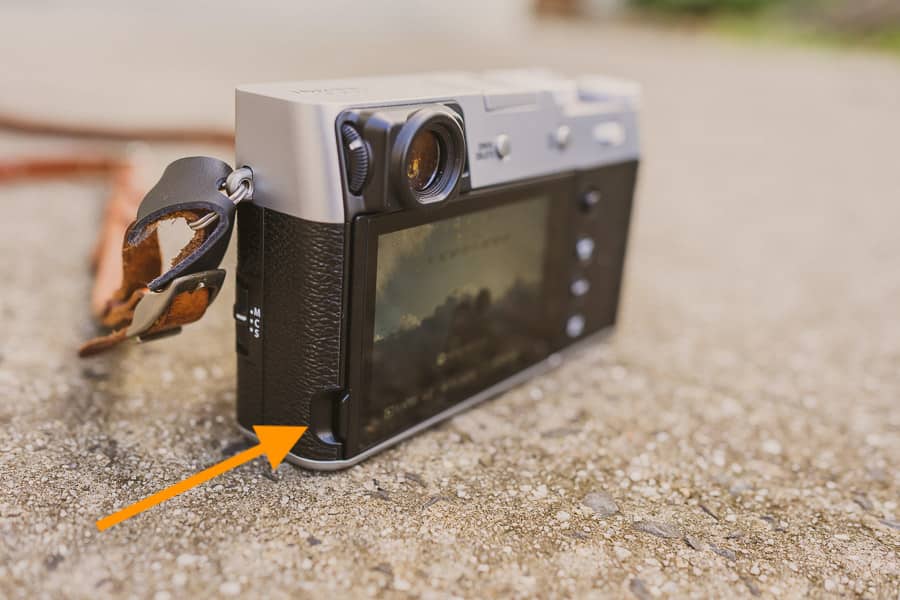
Combined with face/eye detection AF and the convenient and immensely fun touch-to-shoot mode, you can get candid low-level, or not-so-candid above your head shots with ease.
One trick to getting a great photo is by getting lower or higher than the accustomed viewpoint, and the Fujifilm X100V with its tilting touch screen makes this a cinch.
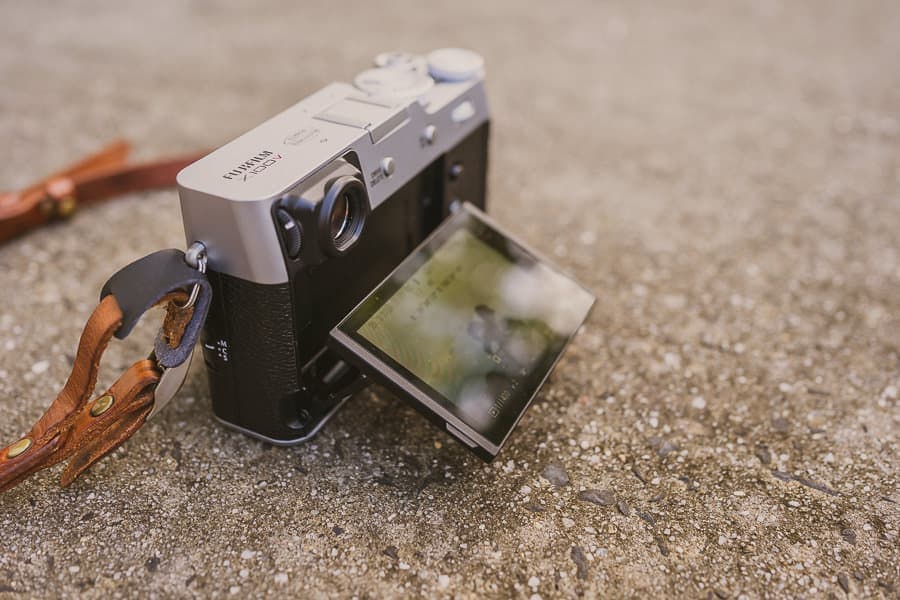
In summary, build quality is excellent and the design is (still) a classic – there may be good Fujifilm X100V alternatives, but there’ll never be a true replacement.
It’s minimalist elegance, ready for display in a design museum.
Ergonomics & Handling
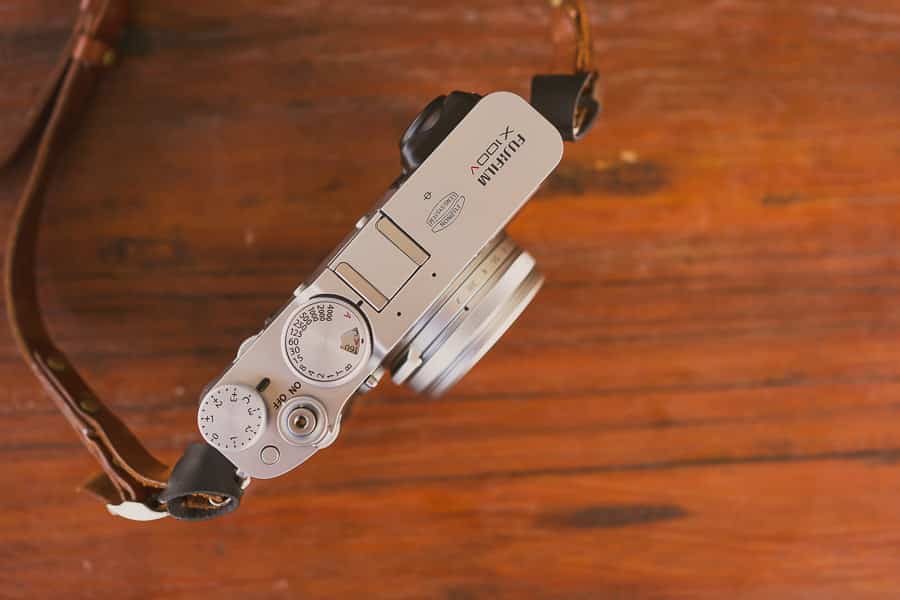
The X100 series has never been great when it comes to ergonomics…
They sure look good, but just like how a pair of Gucci loafers don’t feel so great for a jog around the block, the X100V ain’t designed for all-day shooting!
Don’t get me wrong – dials are well placed and plentiful (1x ISO/shutter and 1x exposure compensation on top, plus; front and rear customisables), the new joystick AF selector works well, and there are just enough buttons to do the job… but there’s a distinct lack of grip.
For a camera that’s almost a street photographer’s dream tool, you really need to hold the X100V with both hands if you don’t want to spend the rest of your afternoon sobbing at the roadside…
The lack of pronounced grip is obviously a deliberate design decision by Fuji, as it’d spoil the camer’s aesthetics. I respect that decision.
However, I wish the plastic front was ‘tackier’ to the touch. As mentioned before, rubber may have solved this.
The X100 series were never meant to be a machine-gun compact camera – we’ll leave that to Sony!
With the Fujifilm X100V, you’re making purposeful finger movements, manually adjusting dials to have a rangefinder experience, or just leaving 99% of the operation to the camera with its excellent auto modes.
Here’s how I shoot with it:
- Auto WB – Fujifilm always nails this
- Auto ISO – 1/200 minimum shutter, Max ISO 6400
- Aperture Priority (Shutter dial set to A)
- Wide AF with tracking
- Face and eye detect on
- Touch to shoot on
Then, with the Exposure Compensation dial set to C, I can use the rear dial to adjust compensation up and down, making my scene lighter or darker. Simple.
The face detect AF picks up any faces in the scene and prioritises the focus to them. All I need to do is press the shutter button, or if I want to override it, I simply tap to focus and shoot on another object on the rear LCD.
It’s an intuitive and fun way to shoot, that isn’t possible with any previous X100 camera.
In summary, the Fujifilm X100V isn’t a workhorse camera. It can be shot professionally, but I don’t believe it’s meant to be, since the ergonomics aren’t appropriate.
However, using it is a joy. The dials and buttons feel great to twist and push, and everything is manual when you want it, and automatic when you don’t.
The best of both worlds in a package that turns heads.
Focus Performance
The first Fujifilm X100 was a ground-breaking camera. An APS-C sensor crammed into a compact body with a hybrid viewfinder, with retro rangefinder good-looks.
Image quality was amazing. However, AF performance was… terrible.
I waited a couple of years and bought the X100S. AF performance? Marginally better, but still annoyingly slow.
A few more years passed and I skipped the X100T and settled on the X100F. AF performance had come a long way, but it still hunted too much for my liking.
I’ve sold each one of my three previous X100 cameras because the subpar focus performance annoyed me. I’m thankful to say, however, that I’ll be keeping my Fujifilm X100V.
The quad-core X-Processor 4 is the X100V‘s powerful CPU, and helps you to capture images with face and eye detection right down to -5EV.
(I’m used to shooting in near total darkness with a Sony a7III, so have high standards when it comes to focus performance.)
While the X100V won’t be winning any focus awards, it’s good enough for my personal shooting needs, and a marked improvement on the X100F.
Yes, it still hunts a bit in low-light, and there’s still room for improvement with focus speed, but it’s still good enough for the majority of photographers.
Face/eye detect works well, and I’m confident to let the camera make the decision for me when shooting people.
If I’m being more deliberate with compositions, the new joystick works well in placing the single AF point on my subject – I don’t miss the d-pad of the X100F at all.
Continuous AF and a burst mode of 11fps is ludicrous from a camera of this size, and totally unnecessary for most peoples’ needs… but it’s a nice party trick that works well. I prefer to ‘limit’ bursts to 6fps, and spend less time culling hundreds of similar images.
Manual focus is a lot of fun, with focus peaking and the lens ring taking care of things when the light becomes too low, or you feel like having more of a MF film camera experience.
To sum up, the Fujifilm X100V is the first camera in the X100 series that won’t cause you to miss shots due to its focus performance.
It’s fast enough for most situations, except in really low light where the lens still tends to hunt.
Image Quality
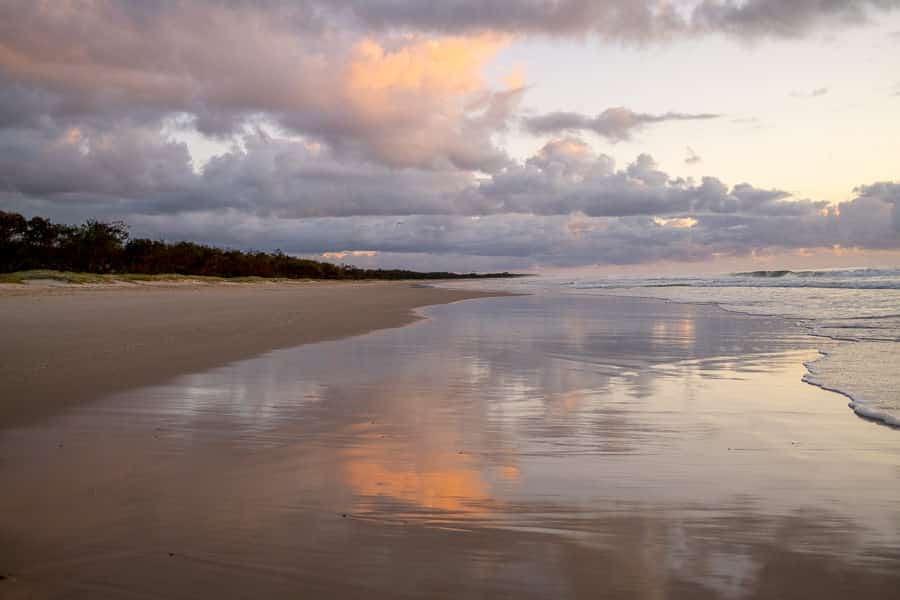
When a straight-out-of-camera JPEG has colours this nice, there’s no need to shoot and edit RAWs anymore.
Anyone who’s ever shot Fujifilm before will know that Fuji’s straight out of camera JPEGs are the best around, regardless of the camera model.
Thanks to the 26.1 MP X-Trans CMOS 4 APS-C sensor and newly designed f/2 23mm lens, the image quality out of the Fujifilm X100V is up there with Fuji’s flagship models.
A unique colour filter array controls moiré and false colour without the need for an optical low pass filter.
As for RAW files, there’s enough dynamic range there to satisfy most photographers. It’s definitely the best you’re going to get with an APS-C sensor, although a far cry from the crazy DR available to modern full frame cameras.
If you ever shot with any previous version of the X100 series, you’ll know that shooting the lens wide-open at f/2 didn’t yield the sharpest results.
With the Fujifilm X100V, I’m happy to say that this is no longer the case. Images shot at f/2 are sharper and more contrasty, even when shot up close in macro mode.
The boost from 24MP of the X100F up to 26MP also helps to highlight the sheer level of detail captured by this lens.
A big reason to buy the X100V is the much improved image quality, not only over its predecessors, but also over the majority of other APS-C cameras in its class.
Being able to apply great-looking film-simulations in-camera really is just the icing on the cake. You’ll be happy to shoot 100% JPEG, and spend no time editing behind a computer.
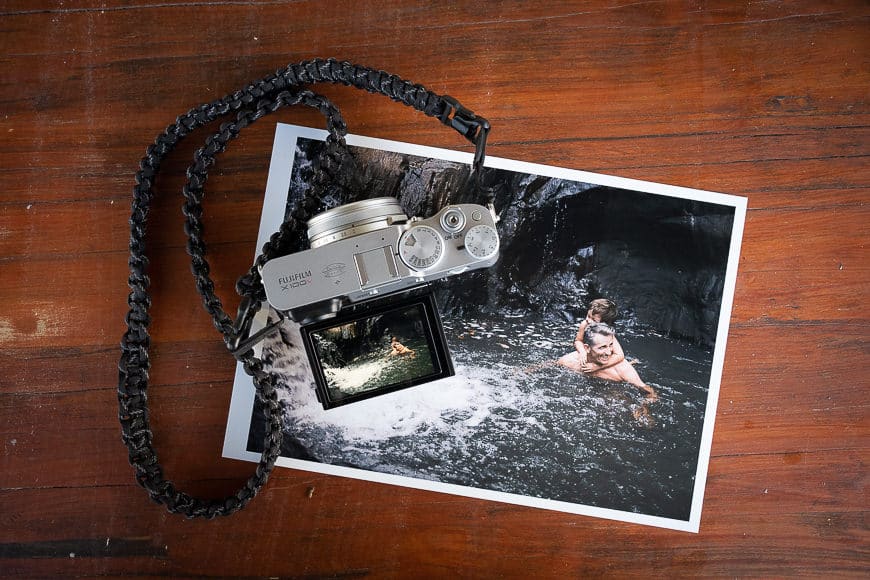
Being able to bypass the computer entirely is a massive time-saver – now I can go from camera to a print with zero editing.
The fixed 23mm focal length is thankfully left unchanged, giving a 35mm equivalent field of view – a highly versatile, easy to use focal length.
Here’s a series of sample images shot during our time in self-isolation. I’ll add more variety when it becomes possible to do so!
Classic Neg Film Simulation
Based on Fujicolor Superia 100 from the 1980s, this is my favourite of the X100V’s film simulations.
Here’s a selection of JPEG images shot with the Classic Neg simulation applied in-camera.
Remember – the images below are entirely unedited. They’ve been uploaded straight from my X100V’s memory card, then resized, and (unfortunately), heavily compressed for online viewing.
(The uncompressed JPEGs are a lot sharper – you’ll have to take my word for it!)
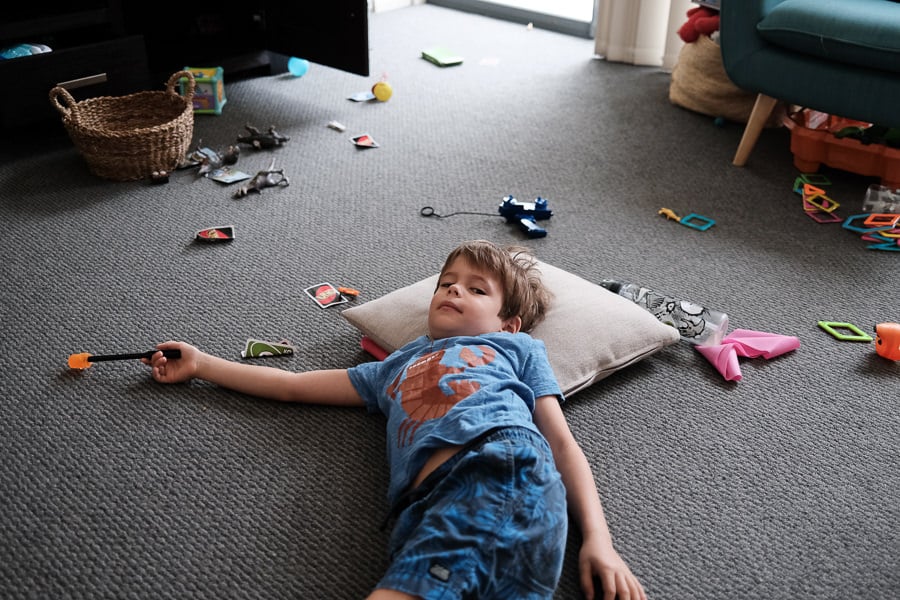


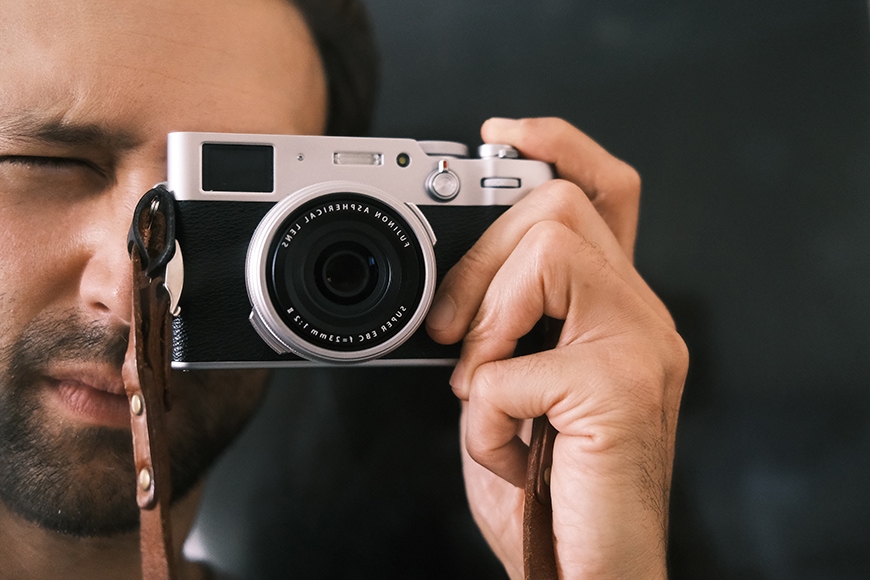
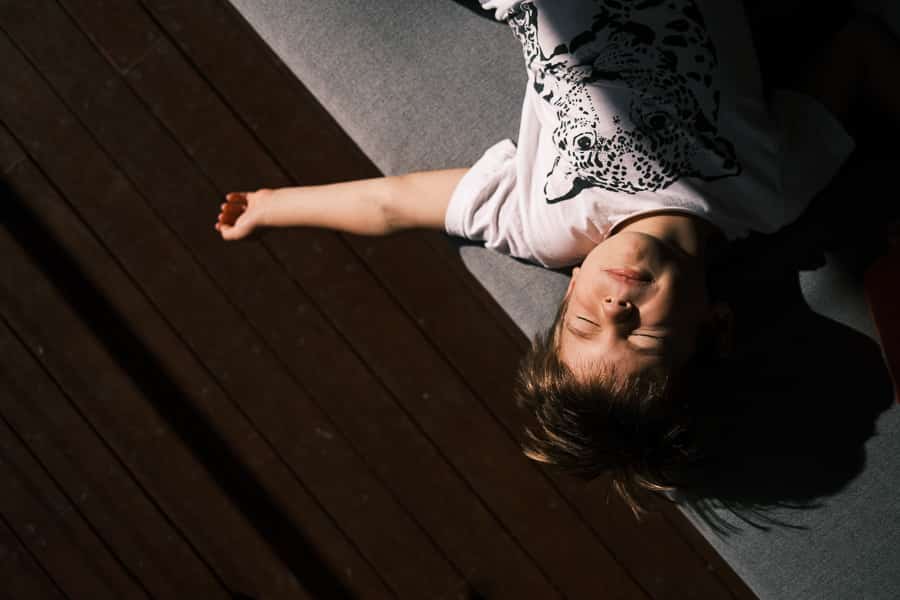
Built in ND Filter
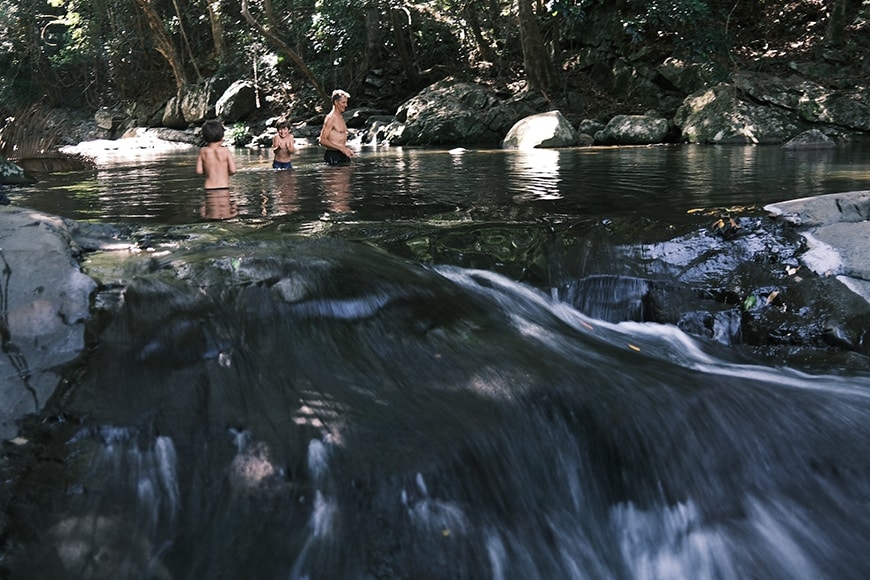
f/2 1/8 ISO100, handheld | Shooting in midday sun using the built in ND filter allows you to show motion in running water.
High ISO
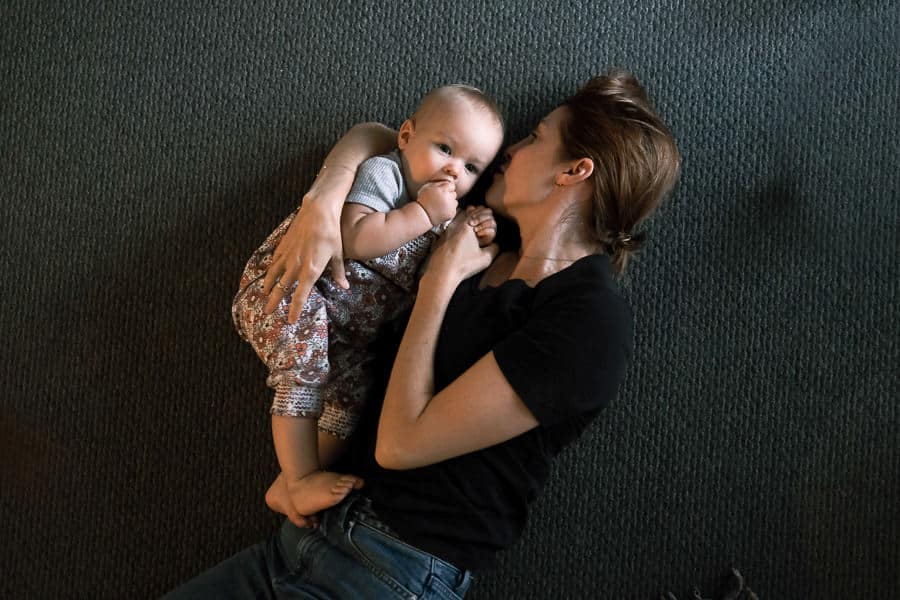
ISO4000 looks good
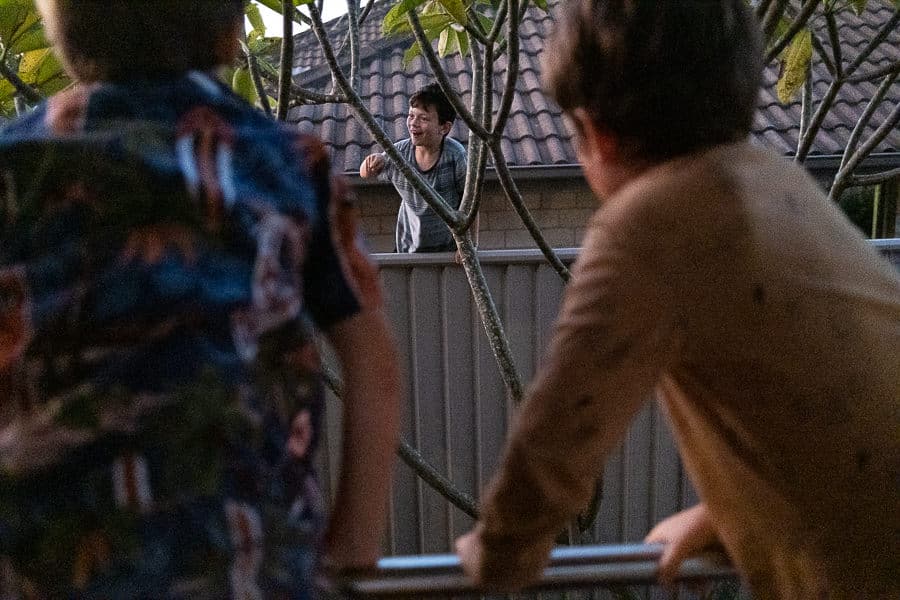
ISO12800 is predictably noisy
Dynamic Range

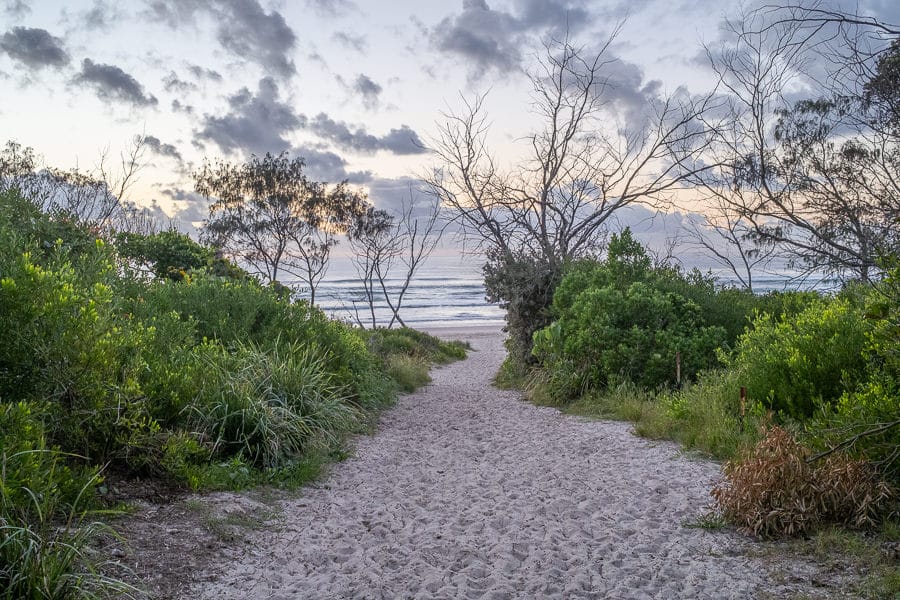
You can pull adequate detail back from the shadows in the RAWs, but highlight recovery is more limited.
Unedited RAW
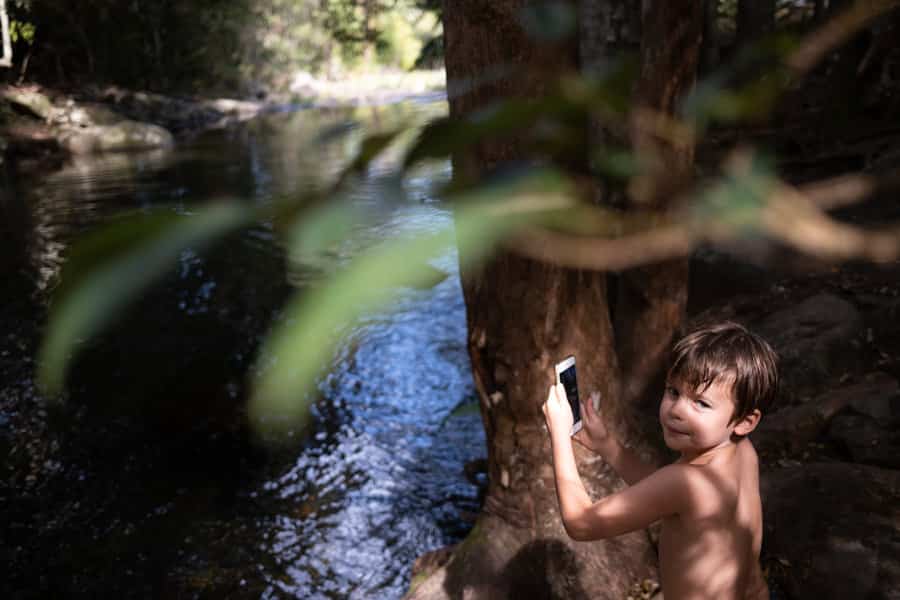
Edited RAW
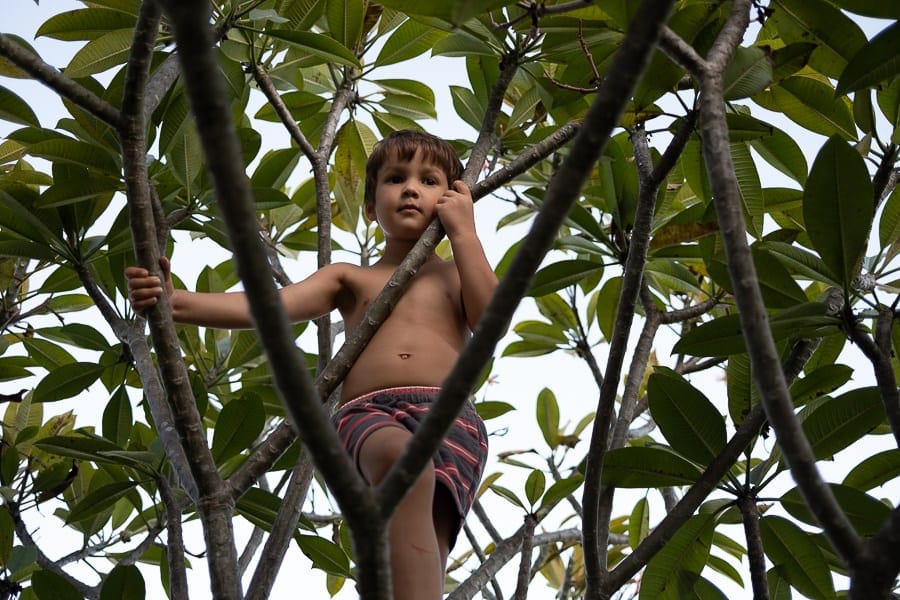

Converted to Adobe Monochrome and increased exposure.
Macro Mode

It may not look it here, but the original image is razor sharp on her eye lashes.
Multiple Exposure
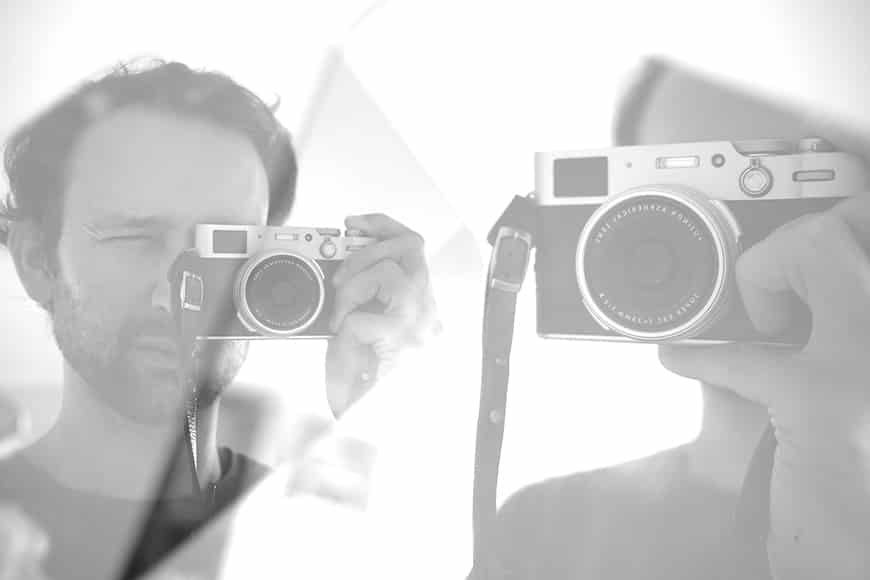
100% Zoom
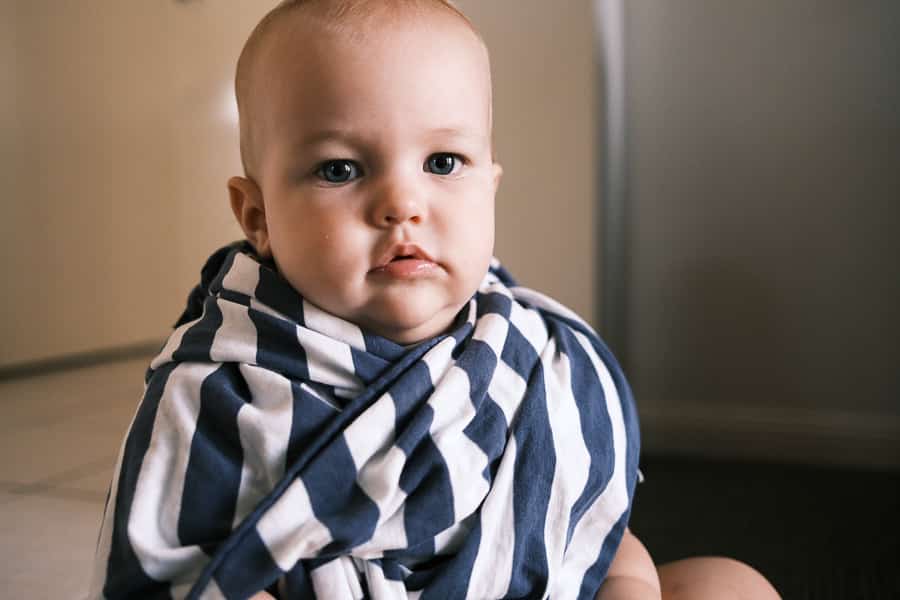
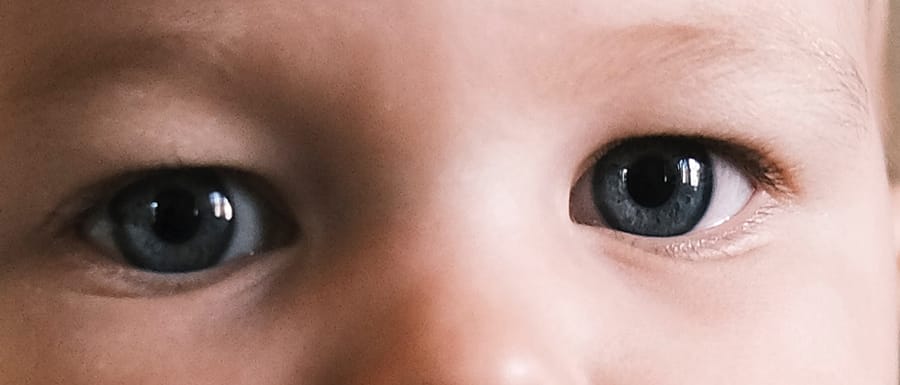
Note the shallow depth of field at f/2 – the difference between the soft left eye and sharp right eye.
Overall Performance
Compared to the X100F, start up times on the Fujfiilm X100V seem faster – it’s ready to shoot in a matter of milliseconds, which makes it a great camera for street photography, or any situation where capturing the moment is paramount.
The new touch screen on the Fujfiilm X100V is nice and responsive, with tap-to-shoot being an immensely enjoyable and efficient way to take candid photos.
Scrolling through images during Playback with your fingertip is great, although occasionally the image seems to ‘stick’ to your finger, requiring you to swipe it again.
As for the buffer, it’s rated at 38 JPEGs, and 17 lossless RAW files at the maximum speed of 11 FPS, using the mechanical shutter.
I prefer to shoot at 6FPS, where the performance is increased to 220 JPEGs, or 21 compressed RAWs (18 uncompressed).
With the electronic shutter, you can get an incredible 20 FPS, with the buffer filling after 32 JPEGS or 17 RAWs.
Buffer performance like this on a compact camera is pretty good, although it’s limited by UHS-I speeds. Unfortunately, this means you can’t get any extra write speed benefit from faster UHS-II cards.
The Fujifilm X100V is clearly not designed for sports photography, but if you want to use it to capture the odd fast-moving subject, you can.
Auto-focus performance is also excellent, and a big upgrade from the X100F. Compared to the older X100 cameras, it’s a night and day difference.
Other Notable Features
-
Bluetooth/Wifi
I have mixed feelings about this. When it works, it’s great – being able to transfer your JPEG photos to a smartphone or tablet using WiFi is great for workflow. Controlling the camera remotely using Bluetooth is useful too.
However, for me at least, it rarely works properly. I’m not sure if it’s iOS related (I don’t have an Android device to compare), but the getting the WiFi and Bluetooth to pair consistently is definitely a mixed bag.
-
Advanced Hybrid Viewfinder
According to Fujifilm, this is the world’s only viewfinder that can be instantaneously switched between an OVF (which captures the photo subject exactly as it is), and an EVF (which reflects exposure and other shooting conditions adjustments.)
It’s kind of like having a DSLR viewfinder (i.e. an OVF) and a mirrorless viewfinder (EVF) in one, except that the OVF on the X100V offers an Electronic Rangefinder function to display a small EVF window at the same time.
This allows you to capture the subject as it is, while enlarging the focusing area in the small EVF to make sure you’ve got your focus spot on.
The rangefinder style OVF is great for street photography, where you can take advantage of the ‘extended’ frame to see your subject entering the ‘main’ frame, allowing you to better anticipate the shot.
I’ve always enjoyed the combined viewfinder experience on the X100 cameras, and on the X100V, everything seems much snappier, with excellent refresh rates and enhanced detail/contrast in the EVF (which now has 3,690,000 dots).
-
Tilting Touchscreen
This was the main reason I decided to upgrade from my X100F. All the other advantages were just a bonus!
I’m delighted to say that the tilting screen mechanism is perfectly integrated, allowing you to get much more creative with your shooting angles, without the screen ruining the minimal aesthetics of the camera.
The touchscreen is excellent too – I love being able to use it as if I were viewing images on my iPhone, and the tap-to-shoot feature is something all compact mirrorless cameras should have.
-
Aperture Ring
This is unchanged since the first X100, but still deserves a mention as it’s so enjoyable to use.
For those who’ve never used an X100-series camera, you change your aperture by twisting a ring which runs around the lens.
It’s an intuitive and fun way to control depth of field, and the feel of it clicking under your fingers as you rotate it is immensely pleasurable! You’ll find yourself playing with it non-stop.
-
Built-In ND Filter
If you want to shoot wide open on the X100V in bright sunlight and want to keep the shutter speed below 1/1000 (in order to blur the background), the ND filter can be enabled with one button press, compensating for 4 stops of exposure.
You can also use it to creatively reduce your shutter speed as much as possible, to exaggerate the smoothness of flowing water, for example. Unfortunately, though, it doesn’t work with video.
-
Movie Function
The Fujifilm X100V is capable of recording smooth 4K video at 30fps, or 60fps in Full-HD modes, and at 10-bit, 4:2:2 colour externally via the HDMI port.
You can record for approximately 55 minutes in 4k video mode, and 75 minutes in 1080p.
There’s also a 2.5mm microphone jack (not sure why they didn’t include a standard 3.5mm!?). The USB-C port can be adapter to use as a headphone jack.
This camera was never meant to be the first choice for serious video work, but it’s nice to see you can still record movies surprisingly well.
4K video quality looks great, and applying a film-simulation mode is a great way for the time-poor to entirely skip any tedious colour-grading in post.
ETERNA mode is a popular simulation for video, replicating the colours and tonality of Fujifilm’s motion picture film, allowing you to record video in subdued colors and rich shadow tones.
It’s just a bummer that you can’t use the built-in ND filter during video capture – this would have been really useful, especially when shooting at 30fps in daylight.
-
Multiple Exposure Mode
You can layer up to 9 images in Additive, Average, Comparative Bright or Comparative Dark exposure modes to, combine multiple perspectives or different points in time.
This gives you tons of creative possibility, and the WYSIWYG overlay view makes it easy and a lot of fun to compose your images on top of each other.
-
USB-C Port
This allows you to handle both data transfer and charging, so it’s especially nice for Mac users especially to be able to repurpose their existing USB-C cables.
It also doubles as a mic-input, if you have an adapter. Yes, dongle-gate is here to stay…!
-
Custom Menu
As well as multiple customizable button, dial, and Q Menu functions, Fujifilm’s My Menu continues to be the most efficient way to get to your most-needed settings.
Much like on other cameras with rather convoluted menu options (hello Sony!), the My Menu allows you to bypass most of the mess, appearing as soon as you press the camera’s Menu button.
-
Eye Sensor
With each iteration of the X100, the responsiveness of the Eye Sensor has improved.
Here with the X100V, the time it takes for the hybrid viewfinder to come to life when your eye is behind it is virtually imperceptible and provides a seamless shooting experience.
-
In-Camera Ratings
I love being able to add star ratings to my photos during playback with the X100V – this allows me to cull images long before I’ve got back to my computer.
When in Lightroom, I can just filter by starred images, and delete everything else.
Fujifilm X100V vs X100F
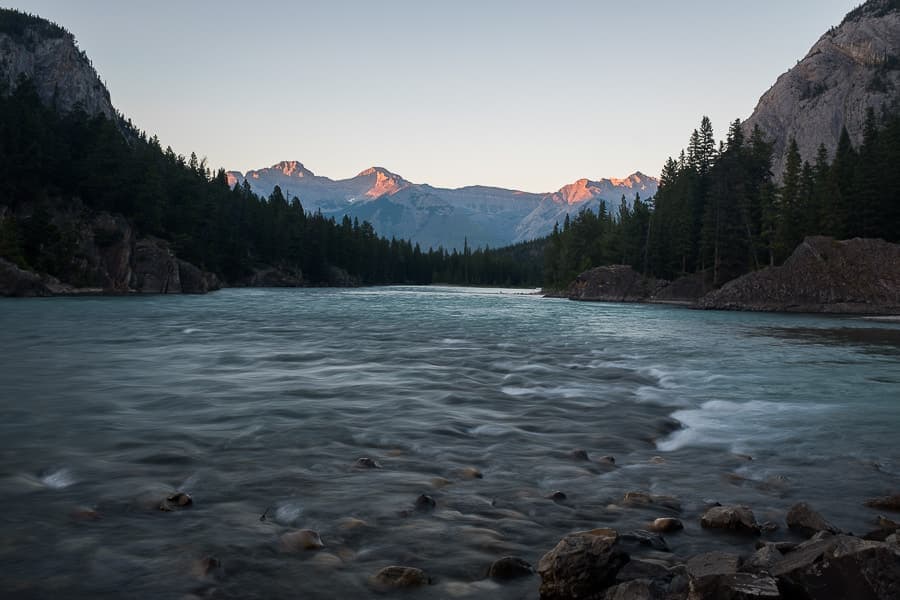
Image I shot 3 years ago with the X100F – it’s hard to show the difference in image quality between these two cameras since they’re both excellent, but the new lens on the X100V definitely delivers sharper results.
If you’re considering the upgrade and have the money, I’ll save you some time – just do it. It’s definitely worth it.
I sold my X100F for less than half the price I purchased it 2 years previous, but haven’t looked back.
Here are the most notable changes to the 2020 X100V since the 2017 X100F:
- Top and bottom milled from solid aluminium
- Weather resistant (using a front filter)
- 26 MP X-Trans CMOS IV sensor, increased from 24 MP
- Base ISO starts at 160, instead of 200
- Sharper, better performing 23mm f/2 lens
- ISO dial’s collar remains up when twisting, as opposed to you having to pull it while turning on X100F
- Rear LCD is tilting 1,620,000 dots touchscreen (X100F had no touchscreen, no tilt, and only 1,040,000 dots)
- Mechanical leaf shutter able to shoot at 1/2000 at all apertures – X100F could only do 1/1000
- Phase Detection autofocus rated to LV -5, with face and eye detection, vs LV -3 on X100F
- EVF has 3,690,000 OLED dots vs 2,360,000 LCD dots of the X100F.
- Longer battery life – 420 shots vs 390
- Optical finder has 0.52× magnification and 95% coverage, vs 0.50× magnification and 92% coverage of the X100F
- Built in 4 stop ND filter, vs 3 stop
- New thumb joystick, vs 4-way d-pad on X100F
- Programmable front control level
- 4K at 30 fps and 1,080 at 120fps for better slo-mo video, up from 1,080/59.94
- Bluetooth version 4.2
If you’re an existing X100F user and you’re on a strict COVID-19 lockdown budget, I highly recommend you never try out an X100V… as you’ll definitely want one!
Take it from me, (an ex-X100F user of 2 years) – the X100V is a much better camera, and well worth the cost of upgrading.
Who is the Fujifilm X100V for?
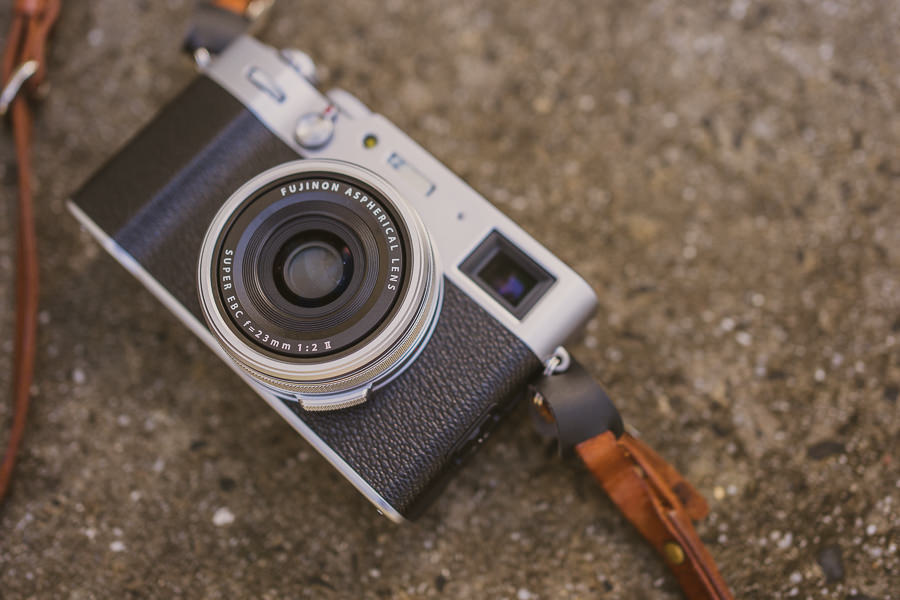
Trying to convince your self you need this camera?! I don’t blame you!
Here are a few usage cases I’ve identified for the Fujfilm X100V:
- For street photographers who are too sensible to buy a $10k Leica
- For street photographers who want to take advantage of a tilting touch screen for more discreet, candid images
- For professionals who want an ‘everyday’ camera, that makes photography a ‘hobby’ again
- For beginners/amateurs who want an all-in-one camera, without the hassle/temptation of lenses
- For anyone who wants to save time spent editing images behind a computer
- For anyone who wants to rekindle the fun and excitement of taking photos.
The long and short of it is this: the Fujifilm X100V is a hugely enjoyable camera to both hold and shoot.
The nostalgic, minimal design is gorgeous. It yearns to be picked up and fondled.
The straight-out-of-camera image quality is excellent and will make you want to take photos of subjects you’re never been interested to shoot before.
It’s quite literally a camera for anyone fortunate enough to be able to afford it.
Value for Money
Justifying the cost of a camera is always a subjective matter, especially if you’re unlikely to be earning a living from it, such is the case with the Fujifilm X100V.
It’s a high quality, highly desirable camera, with a price to reflect. It’s also one of those rare products that people want, no matter the price.
At around US$1,400, I consider it excellent value for money.
Performance is excellent, image quality (especially JPEGs the film simulations) is sublime, it looks and feels great, and is quite simply a camera you want to keep on picking up.
- Is Fujifilm X100V good for beginners?
Yes, the Fujifilm X100V is good for beginners. However, you need to keep in mind that the lens is fixed. As a result, you’ll have to adjust your shooting style, the settings, and the composition of your image or frame to accommodate this.
Fujifilm X100V Review | Conclusion
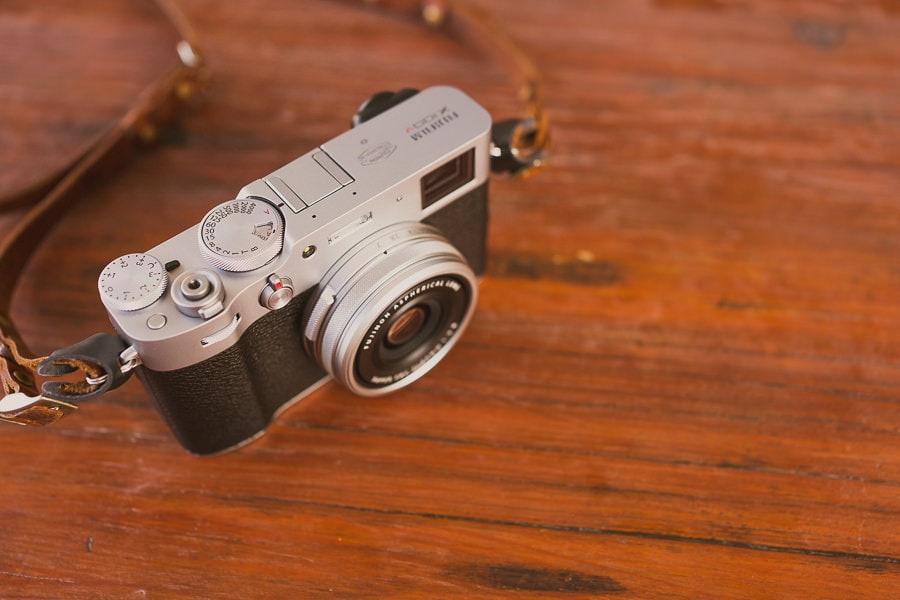
The Fuji catch-copy for this camera reads:
Rediscover photography in a new and exciting way with the one and only, X100V.
I couldn’t have said it any better myself.
This is a camera that makes you want to pick it up and start shooting.
You’ll find yourself taking photos of things that never interested you before… just to see how they look on the back of the X100V.
This is one of the few APS-C sensor cameras that you’ll be confident to shoot in JPEG all day long.
You’ll return home without the burden of post-production – goodbye long hours spent editing behind a computer!
The Fujifilm X100V is the most highly desirable camera of 2024, and a big upgrade from its predecessors.
It’s a camera I’ll have around my neck when I venture out every day… when this damn self-isolation ends, anyway…

Gorgeous, retro-inspired compact camera that's a ton of fun to shoot, with excellent image quality and a unique feature set.







